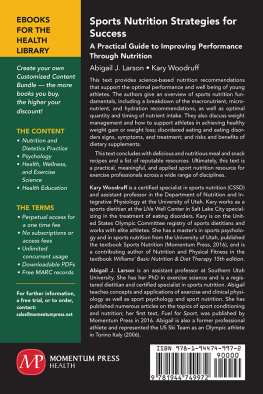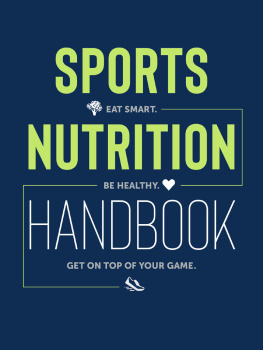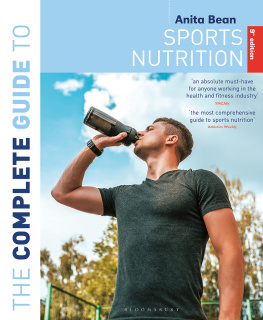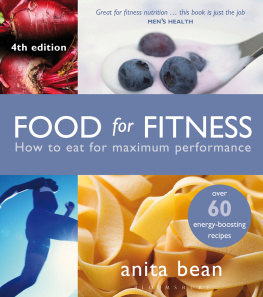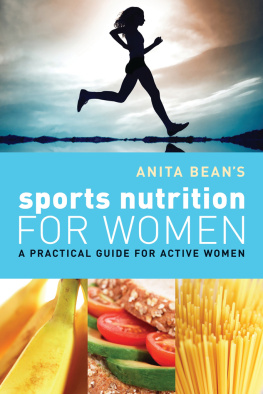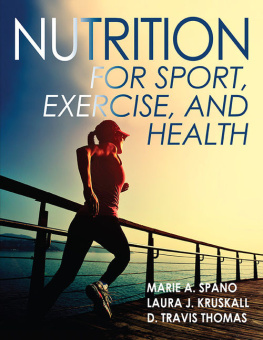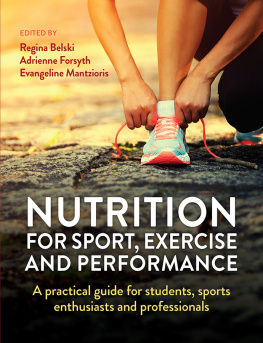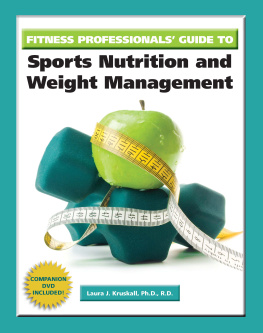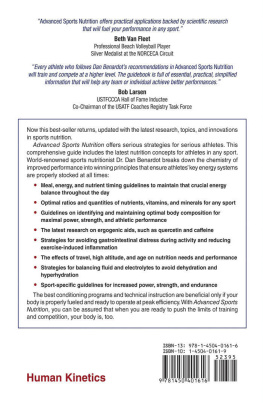Sports Nutrition Strategies for Success
Sports Nutrition Strategies for Success
A Practical Guide to Improving Performance Through Nutrition
Abigail J. Larson
Kary Woodruff

Sports Nutrition Strategies for Success: A Practical Guide to Improving Performance Through Nutrition
Copyright Momentum Press, LLC, 2017
All rights reserved. No part of this publication may be reproduced, stored in a retrieval system, or transmitted in any form or by any meanselectronic, mechanical, photocopy, recording, or any other except for brief quotations, not to exceed 250 words, without the prior permission of the publisher.
First published in 2017 by
Momentum Press, LLC
222 East 46th Street, New York, NY 10017
www.momentumpress.net
ISBN-13: 978-1-94474-997-2 (print)
ISBN-13: 978-1-94474-998-9 (e-book)
Momentum Press Health, Wellness, and Exercise Science Collection
Cover and interior design by S4Carlisle Publishing Services Private Ltd.,
Chennai, India
First edition: 2017
10 9 8 7 6 5 4 3 2 1
Dedication
To DKthanks for everything and to Henry who forfeited a lot of playground and pool time this year.
KWTo Eric who always encourages and supports my passions. I couldnt do this without you. Evelyn and Nora you two support your mother in ways you cannot understand!
Abstract
The intent of this book is to provide science-based nutrition recommendations that will support optimal performance as well as promote the health and well-being of the athlete. The reader can expect an overview of sports nutrition fundamentals, including a breakdown of the macronutrient (carbohydrates, proteins, and fats), micronutrient, and hydration recommendations. Optimal quantity and timing of nutrient intake is also addressed. This information is then expanded upon through applied scenarios and strategies intended to help the reader develop individualized sports nutrition and hydration plans which implement recommendations within the context of busy schedules. This text also addresses weight management issues and how to best support athletes in achieving healthy weight gain or weight loss goals; disordered eating and eating disorders prevention, risks, signs, symptoms, and treatments among athletes; and risks and benefits of dietary supplements (including a helpful risk and application schemata for common dietary supplements); finally this text concludes with a chapter devoted to delicious and nutritious meal and snack recipes and a list of reputable resources for further reading. Ultimately this text is intended to be a practical, meaningful, and applied sport nutrition resource for exercise professionals across a wide range of disciplines.
Keywords
Adolescent Athletes, Coaches Education, Dietary Needs, Exercise Performance, Exercise Science, Meal Planning, Sports Nutrition, Sport Performance
Contents
Athletic success is the result of a myriad of factors, only some of which are controllable. Genetics and luck are beyond the control of the athlete, but appropriate training, rest, and dietary practices allow an athlete the opportunity to reach his or her potential. Nutrition, though often overlooked, is especially important for the young developing athlete. Adolescence and young adulthood is a time of rapid physical development. Young bodies can adapt to the demands of training quickly, but these adaptations can only happen and persist under the right circumstances: optimal training progression, optimal rest, and optimal nutrition. If any of these pieces are missing an athlete can easily become stale, ill, injured, overtrained, or just plainly underperform. It is only through optimally fueling the body that one can optimally train the body. It is only through optimal training that one can reach their athletic potential.
Consider the athlete who is not practicing optimal nutrition strategies. This includes the athlete who arrives to morning practice or a game without having eaten breakfast, or the athlete who trains after school on an empty stomach. These athletes are visibly tired and lethargic. Speed and agility, focus and concentration are hindered. Or consider the athlete playing a 90-minute soccer game who neglects to refuel or hydrate during the game. In the second half of the game this player covers less area of the field, has poor strategic judgement, and diminished accuracy. There is also the example of the athlete trying to make weight for a wrestling match. This individual has restricted energy intake for days and has not consumed any fluids for over 24 hours. He makes his goal weight, but his performance in the match is abysmal and he is at risk for considerable medical complications. These examples show how poor nutrition and hydration habits significantly and negatively affect the physical and cognitive performance of the athlete.
Eating is an integral component of daily sport practices. Just as young athletes need help training, many also need guidance as to how to eat for performance. As such, it is important that coaches, physical educators, athletic trainers, and all those who help athletes, be able to answer basic nutrition queries as well as have an understanding of how to best feed their hungry athletes before, during, and after play. Also important for individuals working with athletes is the ability to identify nutrition-related problems and act appropriately.
S ports Nutrition Strategies for Success: A Practical Guide to Improving Performance through Nutrition is intended to introduce the reader to sports nutrition recommendations and practices. Specifically this text will outline optimal fueling practices for young athletes and practical means of application. The primary objective of this book is to distill how training affects nutrient demands, how to meet these demands, and how optimal, as well as less than optimal, fueling practices can affect short- and long-term sport performance and health. Presented information includes basic macro- and micronutrient functions and recommendations, appropriate timing of food and fluid intake, strategic and individualized meal and snack planning, evidence-based methods and strategies to decrease fat mass and/or increase lean body mass, eating disorders in athletes, risks and benefits of common supplements and ergogenic aids, and recipes to meet activity-based energy and nutrient requirements as well as additional resources for further reading on specific topics of interest.
Ultimately by learning and sharing the tools and concepts presented in this text, you can help athletes take personal interest in developing and maintaining healthy eating habits for a lifetime.
KW and ALWe would like to acknowledge the contributions and information contributed from Kristi Spence, MS, RD, CSSD. Kristi has been a part of this book in many ways and we appreciate all of her wisdom and support. And thanks to Michelle Openshaw, MS, RD who recognized the need and inspired the conception of this text.
Introduction
Having a solid understanding of credible sports nutrition information allows athletes to make educated choices about how to properly fuel their bodies to support optimal performance. Unfortunately, athletes often turn to the Internet and other media sources for sports nutrition information that is not based on the most recent scientific research. This chapter provides an overview of the three macronutrients that provide energy to athletes (carbohydrates, proteins, and fats) and a summary of how the body utilizes this energy. Next it describes the micronutrients (vitamins and minerals) that serve multiple functions in the body and their relevance to athletic performance. Finally, there is an explanation of the role of proper hydration and recommendations for effective hydration strategies. This chapter also addresses practical information regarding the timing of intake so that athletes have an understanding of how to apply this information to improve performance.

